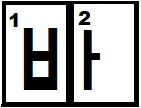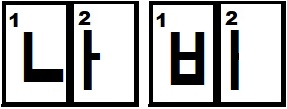Anyeong haseyo - Hello
Actually I should have written: 안녕하세요
But could you have read it?
So let's remedy right away. Korean Scripture is actually pretty easy once you get the hang of it. It is just different...
The Scripture system is called Hangeul and was created by King Sejong in 1443. The King felt that Chinese writing was too complicated, since it allowed only for 'writers' to read and write but not for the common people. He thus created a new scripture from scratch, its letter forms based on mouth and tongue movements while pronuncing the character. You might not necessarily figure that last one out, but let's not too much go into details about that, let's simply start.
What makes Hangeul so different from our scripture are not the characters themselves. Ok, they look different: ㅈ,ㅂ,ㅁ,ㅌ... but you could simply draw a decode chart : and have ㅈ = j, ㅂ= b ... What makes Hangeul so different is that the scripture is divided into syllable blocks. A block can contain 2 - 4 characters. Sometimes those characters are written next to each other (바) at othertimes beneath each other (봉) or still in a combination of both (밝).But don't worry, there is an easy pattern to it. Remember King Sejeong meant to make things easy :D
Imagine yourself a syllable as this:

Number 1 is always a consonant.
Number 2 is always a vowel.
Both places HAVE to be filled in.
So let's have something to fill in this box:
ㄴ= n - n being a consonant will go into slot 1.
ㅏ= a - a being a vowel will go into slot 2.
which gives us this:

Of course in normal writing you are not gonna draw those boxes :D I show you those boxes to give you an idea of where the letters go and how they are spaced. In real life our first word would look like: 나
Now come to read it. We read from left to right. N + a = na - doesn't look to scary yet, does it?
Na means 'I' as you might use it among friends. There is a more respectful word which we will learn later. Right now we care for reading. So don't go around and blab to anybody...
Let's have another vowel:
ㅣ= i
You could of course now write 'ni', just replacing the second character with our new one... But what if you just wanted to write 'i'. I have told you that a vowel can't be the first letter in a syllable block. The answer to this conundrum is: We have a neutral consonant. It looks like a zero - I like to remember it as such- and it goes into the first box. Like this:

i means this
Now try to read this:

Could you read it ?
a-i = child( the two syllables are pronounced seperate.)
You can even write: this child

이 아이 = i a-i = this child
Time for a new letter:
ㅂ= b (looks like a glass of beer. So let's write the Korean word for pub We are getting serious now :D The word for beer is maegju btw.

바 = ba = pub
And here we hit our first obstacle. In an ideal world 바 would be pronounced ba > b + a = ba. But languages are made by humans, nothing is ever ideal... :D
The character ㅂ = b is pronounced b only when in the middle of a word (or a syllable , if there is only one) otherwise it is pronounced p. So by consequence our 'ba' turns into a pa. Just you wait before this lesson is over I will make you eat pananas XD
Let's read some more words:

나이 = na- i = age

나비 = na-bi = butterfly.
Here our ㅂ is in the middle of the word, so it remains b. However, ask a Korean to say this word slowly, syllable by syllable to you, because you want to hear whether he said b or p and he will say: na - pi. (because he said seperate syllables)
So we have to do the calculation on our own
na + pi = nabi
Don't worry, you will get used to it.
In the meantime have a

바나나 = panana = banana
